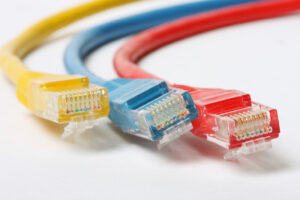[vc_row][vc_column][vc_column_text]
If the cabling of your company does not meet the requirements for needed new equipment, your team must begin planning the installation of new cabling for a network upgrade. A site visit will allow your team to catalog the types of cabling that were installed, along with any problems decreasing network performance. The inspection should also review areas of the facility as listed below:
- Backbone area (vertical cabling)
- Distribution area (horizontal cabling)
- Telecommunication rooms
- Work areas of users
Your team will eventually decide what types of cables will be installed for the network upgrade. Every type of cable is designed for particular applications and environments. Unshielded twisted-pair is the most common type of LAN cable. Their installation is easier, less costly, and provides high bandwidth. Fiber-optic cable is typically installed for runs between buildings and lengthy backbone runs. Although not usually used for LANs, coaxial cable is commonly utilized in cable modem provider networks.
Below is a summary of the common types of network cable.
Common Network Cables
Shielded twisted-pair (STP) – Typically CAT 5, 5e, or 6 cables, STP features foil shielding for protection from EMI (electromagnetic interference). It has a distance limitation of about 328 feet or 100 meters.
Unshielded twisted-pair (UTP) – Typically CAT 5, 5e, or 6 cables, UTP does not contain additional shielding from EMI. However, it is more affordable, costing less than STP cabling. As it is more sensitive to EMI, UTP installation should be only used away from areas that are electrically noisy. It also has a distance limitation of about 328 feet or 100 meters.
Coaxial cable – Featuring a solid copper core, coaxial is covered by several protective layers, which are polyvinyl chloride (PVC), braided wire shielding, and plastic wrapping. It has a distance limitation of several miles or kilometers, which will be determined by the connection’s purpose.
Fiber-optic cable – Invulnerable to EMI, fiber-optic cable is capable of transmitting data at faster rates and longer distances than copper cabling. Fiber-optic cables have distance limitations of several miles or kilometers.
Part 2 will discuss UTP Cables and Structured Cabling.
Progressive Office Cabling
Founded in 1986, Progressive Office’s success has been a direct result of years of commitment to seeking cost-effective solutions. Working together, Progressive teams are committed to getting your data cables installed and operating while minimizing disruption and downtime. Call our toll free number (800) 614-4560 today. Click here to tell us about your project.
[/vc_column_text][/vc_column][/vc_row]

